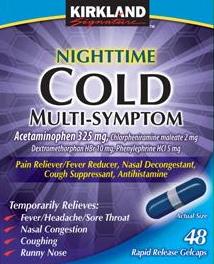Cold Multi-Symptom (Nighttime) Interactions
There are 677 drugs known to interact with Cold Multi-Symptom (Nighttime) (acetaminophen/chlorpheniramine/dextromethorphan/phenylephrine), along with 11 disease interactions, and 2 alcohol/food interactions. Of the total drug interactions, 102 are major, 561 are moderate, and 14 are minor.
- View all 677 medications that may interact with Cold Multi-Symptom (Nighttime)
- View Cold Multi-Symptom (Nighttime) alcohol/food interactions (2)
- View Cold Multi-Symptom (Nighttime) disease interactions (11)
Most frequently checked interactions
View interaction reports for Cold Multi-Symptom (Nighttime) (acetaminophen / chlorpheniramine / dextromethorphan / phenylephrine) and the medicines listed below.
- acetaminophen
- albuterol
- atorvastatin
- baclofen
- Benadryl (diphenhydramine)
- benzonatate
- cyclobenzaprine
- doxycycline
- famotidine
- Fish Oil (omega-3 polyunsaturated fatty acids)
- gabapentin
- Gas-X (simethicone)
- glipizide
- hydroxyzine
- ibuprofen
- Iron Sulfate (ferrous sulfate)
- ketotifen ophthalmic
- lamotrigine
- levothyroxine
- lisinopril
- Lyrica (pregabalin)
- magnesium citrate
- magnesium glycinate
- metformin
- Norco (acetaminophen / hydrocodone)
- propranolol
- spironolactone
- trazodone
- Tylenol (acetaminophen)
- Vitamin D3 (cholecalciferol)
Cold Multi-Symptom (Nighttime) alcohol/food interactions
There are 2 alcohol/food interactions with Cold Multi-Symptom (Nighttime) (acetaminophen / chlorpheniramine / dextromethorphan / phenylephrine).
Cold Multi-Symptom (Nighttime) disease interactions
There are 11 disease interactions with Cold Multi-Symptom (Nighttime) (acetaminophen / chlorpheniramine / dextromethorphan / phenylephrine) which include:
- alcoholism
- liver disease
- cardiovascular disease
- PKU
- anticholinergic effects
- asthma/COPD
- cardiovascular
- renal/liver disease
- BPH
- diabetes
- glaucoma
More about Cold Multi-Symptom (Nighttime) (acetaminophen / chlorpheniramine / dextromethorphan / phenylephrine)
- Cold Multi-Symptom (Nighttime) consumer information
- Compare alternatives
- Drug images
- Side effects
- Dosage information
- During pregnancy
- Drug class: upper respiratory combinations
Related treatment guides
Drug Interaction Classification
| Highly clinically significant. Avoid combinations; the risk of the interaction outweighs the benefit. | |
| Moderately clinically significant. Usually avoid combinations; use it only under special circumstances. | |
| Minimally clinically significant. Minimize risk; assess risk and consider an alternative drug, take steps to circumvent the interaction risk and/or institute a monitoring plan. | |
| No interaction information available. |
See also:
Further information
Always consult your healthcare provider to ensure the information displayed on this page applies to your personal circumstances.


